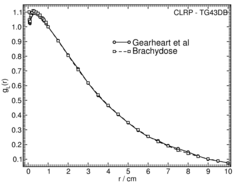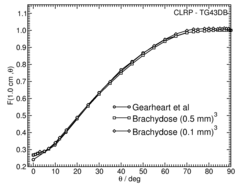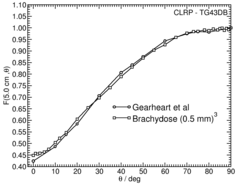

Source Description:
Dimensions given in the paper by Gearheart et al are used for the Imagyn source 1,2,3,4,5 . The Imagyn source consists of five silver spheres, each with a diameter of 0.640 mm, coated with AgI and encapsulated in a titanium tube with 0.500 mm thick hemi-spherical end welds. The end welds are modelled as 0.400 mm hemispheres on top of solid cylinders that have a 0.400 mm radius and are 0.100 mm thick. The center of the spheres are along the seed axis offset 0.690 mm from each other. The tube has 0.050 mm thick walls and an outer diameter of 0.800 mm. The AgI coating is assumed to have negligible thickness in this study. The overall length is 4.50 mm and the active length is 3.40 mm. The maximum possible displacement of a source sphere is 0.350 mm along the seed axis as well as up to 0.030 mm in the radial direction.Dose Rate Constant - Λ :
Dose rate constants, Λ , are calculated by dividing the dose to water per history in a (0.1 mm) 3 voxel centered on the reference position, (1 cm,Π/2), in the 30x30x30 cm 3 water phantom, by the air kerma strength per history (scored in vacuo ). As described in ref. 5 , dose rate constants are provided for air kerma strenth calculated using voxels of 2.7x2.7x0.05 cm 3 (WAFAC) and 0.1x0.1x0.05 cm 3 (point) located 10 cm from the source. The larger voxel size averages the air kerma per history over a region covering roughly the same solid angle subtended by the primary collimator of the WAFAC 6,7 at NIST used for calibrating low-energy brachytherapy sources and is likely the most clinically relevant value. The small voxel serves to estimate the air kerma per history at a point on the transverse axis.
| Author | Method | Λ (cGy h-1 U-1) | Abs. Uncertainty |
| R. E. P. Taylor et al 5 | WAFAC | 0.924 | 0.003 |
| R. E. P. Taylor et al 5 | point | 0.923 | 0.003 |
| G. S. Ibbott 4 | point (PTRAN) | 0.92 | N/A |
| G. S. Ibbott, R. Nath 3 | TLD | 0.92 | 0.07 |
| R. Nath, N. Yue 2 | TLD | 0.95 | 0.095 |
| M. J. Rivard et al 8 | Consensus Value | 0.940 |
Radial dose function - g(r):
The radial dose function, g(r), is calculated using both line and point source geometry functions and tabulated at 36 different radial distances ranging from 0.05 cm to 10 cm. Fit parameters for a modified polynomial expression are also provided 9 .
| Fitting coefficients for g L (r) = (a 0 r -2 + a 1 r -1 +a 2 + a 3 r +a 4 r 2 + a 5 r 3 ) e -a 6 r | ||||||||
| Fit range | Coefficients | |||||||
| r min (cm) | r max (cm) | a 0 / cm 2 | a 1 / cm | a 2 | a 3 / cm -1 | a 4 / cm -2 | a 5 / cm -3 | a 6 / cm -1 |
| 0.05 | 10.00 | 1.0827E-03 | -3.0314E-02 | 1.2465E+00 | 1.7819E-01 | -2.2716E-02 | 1.0380E-03 | 3.1760E-01 |
Anisotropy function - F(r,θ):
Anisotropy functions are calculated using the line source approximation and tabulated at radii of 0.1, 0.15, 0.25, 0.5, 0.75, 1, 2, 3, 4, 5, 7.5 and 10 cm and 32 unique polar angles with a minimum resolution of 5 o . The anisotropy factor, φ an (r), was calculated by integrating the solid angle weighted dose rate over 0 o ≤ ϑ ≤ 90 o .
References:
1. D. M. Gearheart et al , Dosimetric characteristics of a new 125 I brachytherapy source, Med. Phys., 27 , 2278 -- 2285, 2000
2. R. Nath, N. Yue, Dose distribution along the transverse axis of a new 125 I source for interstitial brachytherapy, Med. Phys., 27 , 2536 -- 2540, 2000
3. G. S. Ibbott, R. Nath, Dose-rate constant for Imagyn 125 I brachytherapy source, Med. Phys., 28 , 705, 2001
4. G. S. Ibbott, Monte Carlo determination of dose rate constant, Med. Phys., 29 , 1637 -- 1638, 2002
5. R. E. P. Taylor et al , Benchmarking BrachyDose: voxel-based EGSnrc Monte Carlo calculations of TG--43 dosimetry parameters, Med. Phys., 34 , 445 -- 457, 2007
6. R. Loevinger, Wide-angle free-air chamber for calibration of low--energy brachytherapy sources, Med. Phys., 20 , 907, 1993
7. S. M Seltzer et al , New National Air-Kerma-Strength Standards for 125 I and 103 Pd Brachytherapy Seeds, J. Res. Natl. Inst. Stand. Technol., 108 , 337 -- 358, 2003
8. M. J. Rivard et al , Update of AAPM Task Group No. 43 Report: A revised AAPM protocol for brachytherapy dose calculations, Med. Phys., 31 , 633 -- 674, 2004
9. R. E. P. Taylor, D. W. O. Rogers, More accurate fitting of 125 I and 103 Pd radial dose functions, Med. Phys., 35 , 4242--4250, 2008
Carleton Laboratory for Radiotherapy Physics
December 17 2007.


